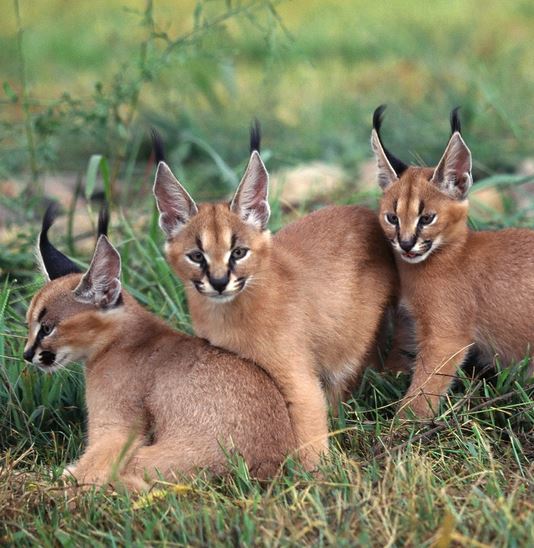
Caracals are found across Africa, the Middle East, and Southwest Asia into India.
For feline lovers that’s usually enough to get their attention. Cats occupy a place in millions of households across the US and Canada. There is something appealing about the way cats move through the world with equal parts grace and mischief. For many cat people who travel, the opportunity to encounter some of the world’s great cats is high on their bucket lists.
Africa naturally comes first to mind when talking about big cats. The continent is blessed with many members of the cat family, even though the numbers are dramatically dwindling. But other regions in Asia and Latin America have their felines as well. While seeing them in the wild is becoming increasingly difficult, there are still wild cat experiences to be had.
Kalahari’s Black Mane Lions
The Kalahari Desert is home to the legendary black-maned lions. These desert-dwelling lions are sometimes larger than their golden-mane counterparts. They are striking for the contrast between their tawny bodies and the long black manes that surround the face. They inhabit part of this immense desert of scrub and sand that lies between South Africa, Botswana and Namibia. There is nothing more magical than catching a glimpse of one of these amazing lions at a waterhole before it sets off on a hunt. You can go on safari in search of black-mane lions as well as springbok, buffalo, kudu, hyena, meerkat, cheetah and antelope, at the Tswalu Kalahari Game Reserve in the Kalahari grasslands of the Northern Cape, the largest private game reserve in South Africa, and the historical home of the Bushmen (San) people. South Africa’s Unique Lodges
Tree climbing lions of Queen Elizabeth National Park
Unlike leopards, lions, for the most part, do not climb trees. In fact, there are only two populations in Africa where lions are known to regularly scamper up trees as part of their behavior. One of these populations is found within the Ishasha sector in the south section of Queen Elizabeth National Park within Uganda, while the other is found the southern part of Tanzania. While there is no definitive reason for this behavior: some believe they do it to protect themselves against the swarms of biting tsetse flies on the ground level, and others to escape from the heat on the ground. Whatever the answer, you will marvel as you spot them sleeping on branches in the afternoon. Discover the lions of Uganda as well as its magnificent gorillas on our 11-day Uganda
Masai Mara and the Caracal
The caracal is actually distributed across Africa, the Middle East, and Southwest Asia into India. It can be found in dry savanna and woodland areas, scrubland and rugged terrain in mountainous regions. In Africa, the historical range of the caracal is similar to that of the cheetah; both overlap with the range of several small desert gazelles. It resembles the lynx with its characteristic dark tufts on its large, pointed ears. It is often called the African lynx or desert lynx, however the caracal is not closely related to the true lynx species. It can survive for long periods without water, as it gets moisture through its prey. Much like leopard, the caracal will sometimes store its larger prey up in the lower limbs of trees and return to feed on its kill over several days. It is also well known for using its agility and superior jumping ability to catch birds just after take-off. Be warned, spotting a caracal is a rare experience and one to be relished for those who do. A good place to look for this shy cat is on our Northern Kenya & Masai Mara safari.
Leopards of Jawai
Many people are not aware there India has leopards. Indeed, the leopard is one of the five big cats found in India, apart from Asiatic lion, Bengal tiger, snow leopard and clouded leopard. Like so many other endangered species, including others mentioned here, a significant immediate threat to wild leopard populations is the illegal trade in poached skins and body parts between India, Nepal and China. In addition to poaching, it has been classified as Near Threatened since 2008 due to habitat loss and fragmentation and persecution due to conflict situations. You can still encounter these great cats while staying at Jawai Leopard Camp on our Deserts of North India adventure.
Jaguars of Manu National Park
The jaguar is the only living member of the Panthera species native to the Americas. It is the third-largest cat after the tiger and the lion, and the largest in the Americas. Peru’s Manu National Park was established in 1973 and is a designated a UNESCO World Heritage Site. Manu is internationally acclaimed as one of the most biodiverse areas on earth. Manu’s jaguars share the reserve with more than 200 other species of mammals including puma and ocelot and in its heart indigenous peoples as yet untouched by civilization. The jaguar is the principle predator of the Amazon jungle and is at the top of the food chain. The biggest threat that jaguars face is habitat destruction. It is difficult to estimate the amount of jaguars living in the whole of the jungle, but you have chance of spotting this feline that resembles a leopard in this protected national park. You might even catch sight of one relaxing on a river bank basking in the sun. The best month to see these beautiful cats is May, June and July. They are both nocturnal and day creatures and their territory covers a huge amount of ground. They have a large variety of vocalizations from a roar to a purr. An exploration of Manu National Park can easily be incorporated into your Peru itinerary such as the Peru – Amazon, Andes & the Coast.